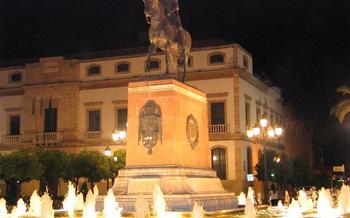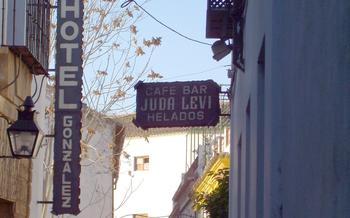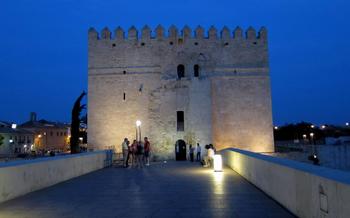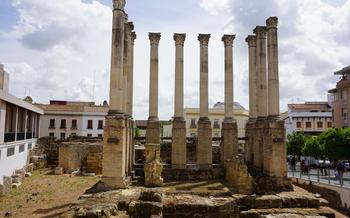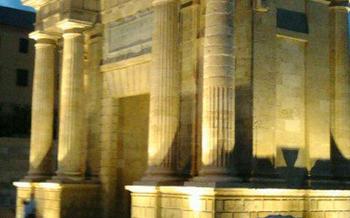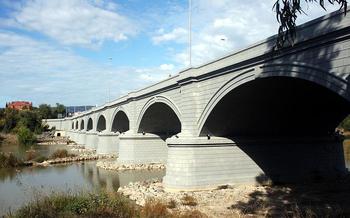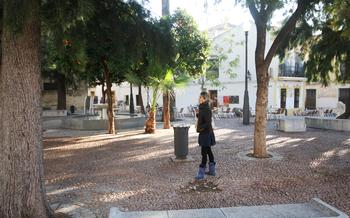
Puerta del Puente
- The Bridge Gate: A Historical Monument in Cordoba
- A Stroll Through History: Exploring the Puerta del Puente
- Architectural Marvels: Unraveling the Details
- Walk the Walls: A Panoramic Perspective
- Landmark on the Guadalquivir: The River's Gateway
- A Walk Through Time: The Neighborhood of San Basilio
- Festivals and Celebrations: A Vibrant Cultural Scene
- Local Legends and Folklore: Tales of the Gate
- Literary Inspirations: The Gate in Literature
- The Gate in Art: Capturing its Essence
- Capture the Moment: Photography Tips
- Beyond the Gate: Exploring Cordoba's Treasures
- Insider Tip: Discovering the Hidden Courtyard
The Bridge Gate: A Historical Monument in Cordoba
The Puerta del Puente, or the Bridge Gate, stands as a testament to Cordoba's rich history and architectural heritage. Built in the 16th century, this imposing gate served as the main entrance to the city from the south. Its strategic location at the southern end of the Roman bridge over the Guadalquivir River made it a crucial passageway for trade and travel. The gate's historical significance lies in its role as a defensive structure, protecting Cordoba from potential invaders. Its sturdy construction and imposing presence symbolized the city's strength and resilience. Over the centuries, the Puerta del Puente has undergone several renovations and restorations, ensuring its preservation as a beloved landmark that continues to captivate visitors with its architectural grandeur and historical significance.
A Stroll Through History: Exploring the Puerta del Puente
The Puerta del Puente, or the Bridge Gate, stands as a testament to Cordoba's rich and storied past. Step through its ancient archway and be transported back in time to the vibrant days of Moorish rule. In the 9th century, Cordoba flourished as the capital of the Islamic Emirate, and the gate served as a vital entrance to the city. It played a significant role in defending Cordoba from invaders, with its sturdy construction and strategic positioning providing a formidable barrier.
Over the centuries, the Puerta del Puente has witnessed countless historical events. It has seen the rise and fall of empires, the changing tides of war and peace, and the ebb and flow of civilizations. The gate's location at the heart of the city made it a focal point for both trade and defense, as well as a symbol of Cordoba's resilience and strength. Its strategic significance ensured that it remained a crucial part of the city's fortifications throughout its history.
Architectural Marvels: Unraveling the Details
The Puerta del Puente stands as a testament to the architectural prowess of its builders. Its unique horseshoe arch design, a hallmark of Islamic architecture, creates a striking visual element that draws the eye. The gate's intricate carvings and inscriptions showcase the meticulous craftsmanship of the artisans who created it. Islamic and Roman influences blend harmoniously, reflecting Cordoba's rich cultural heritage and its position as a crossroads of civilizations. The decorative elements on the gate hold symbolic meanings, adding layers of depth and significance to its design. The intricate patterns, verses from the Quran, and depictions of plants and animals serve as reminders of the gate's religious and cultural significance. Unraveling the details of the Puerta del Puente offers a glimpse into the artistry and craftsmanship that shaped this architectural marvel.
Walk the Walls: A Panoramic Perspective
Strolling along the ancient city walls atop the Puerta del Puente offers a unique and breathtaking perspective of Cordoba. Visitors can immerse themselves in history as they explore the ramparts and towers, marveling at the intricate details and strategic significance of this defensive structure. The panoramic views from the walls are simply stunning, showcasing the city's architectural wonders, the meandering Guadalquivir River, and the surrounding countryside. Each step along the ramparts tells a tale of Cordoba's rich past, making this walk an unforgettable experience for history enthusiasts and nature lovers alike.
Landmark on the Guadalquivir: The River's Gateway
The Puerta del Puente stands as a testament to Cordoba's deep connection with the Guadalquivir River. Its strategic positioning at the heart of the city, guarding the entrance to the old Roman bridge, highlights the river's pivotal role in Cordoba's history. The Guadalquivir has always been the lifeblood of the city, providing sustenance, trade routes, and a means of transportation.
The gate's proximity to the river allowed for easy access to the fertile lands beyond, fostering agricultural development and economic prosperity. The river also served as a gateway to the Mediterranean Sea, connecting Cordoba to the wider world and facilitating cultural exchange. In ancient times, the river was a bustling hub of activity, with boats laden with goods and people crossing under the watchful eye of the Puerta del Puente.
Beyond its economic significance, the Guadalquivir holds deep cultural and spiritual meaning for the people of Cordoba. The river's gentle flow and shimmering waters have inspired countless artists, poets, and musicians throughout the ages, becoming an enduring symbol of the city's identity. The Puerta del Puente, standing sentinel over this majestic river, embodies the enduring bond between Cordoba and its life-giving source.
A Walk Through Time: The Neighborhood of San Basilio
Venturing beyond the Puerta del Puente, one finds oneself immersed in the vibrant neighborhood of San Basilio. This historic district, nestled alongside the Guadalquivir River, offers a glimpse into the heart and soul of Córdoba. Narrow cobblestone streets, adorned with whitewashed houses, unfold like a labyrinth, inviting visitors to explore its hidden gems.
San Basilio boasts an array of significant landmarks, including the picturesque Plaza de la Corredera, renowned for its bustling atmosphere and traditional architecture. The neighborhood's cultural heritage is further enriched by the presence of the Museo Arqueológico de Córdoba, housing a vast collection of archaeological treasures from the city's rich past.
A stroll through San Basilio reveals a tapestry of local stories and anecdotes, passed down through generations. One might stumble upon a secluded patio, where the scent of jasmine fills the air, or discover a hidden chapel, adorned with intricate tilework, that speaks to the neighborhood's deep-rooted spirituality.
San Basilio is also renowned for its culinary delights. Visitors can savor traditional Andalusian cuisine at charming restaurants, indulge in freshly baked pastries at local bakeries, or sip a glass of wine at a cozy tapas bar. The neighborhood's vibrant atmosphere extends beyond its architecture and history, offering a glimpse into the daily lives and traditions of the Cordobans.
Whether seeking cultural immersion, culinary adventures, or simply a tranquil escape, the neighborhood of San Basilio offers a captivating experience that complements the grandeur of the Puerta del Puente. It is a place where the past and present intertwine, inviting visitors to delve into the essence of Córdoba's rich heritage.
Festivals and Celebrations: A Vibrant Cultural Scene
The Puerta del Puente is not just a historical monument but also a vibrant cultural hub that hosts various festivals and celebrations throughout the year. These events showcase the city's rich cultural heritage and bring the community together. One of the most notable festivals is the Feria de Córdoba, which takes place in May and transforms the city into a lively carnival. The streets are adorned with colorful decorations, and locals and tourists alike gather to enjoy music, dancing, and traditional food.
During the Patios Festival, held in May, the neighborhood surrounding the gate comes alive with beautiful flower-filled courtyards. Visitors can wander through the streets, admiring the intricate displays and experiencing the warm hospitality of the local residents. The Córdoba Guitar Festival, held in July, celebrates the city's passion for music and features performances by renowned guitarists from around the world.
These festivals provide an excellent opportunity to witness Cordoba's vibrant cultural scene and immerse oneself in the city's traditions. The Puerta del Puente, with its historical significance and symbolic presence, serves as a backdrop for these celebrations, adding to the overall festive atmosphere.
Local Legends and Folklore: Tales of the Gate
The Puerta del Puente is not merely a historical monument but a wellspring of captivating local legends and folklore. One tale tells of a beautiful Moorish princess who, forbidden from marrying her Christian lover, threw herself from the gate's ramparts, forever binding her spirit to the site. Another legend speaks of a hidden treasure buried beneath the gate, guarded by a fierce dragon that emerges on moonlit nights. These legends, passed down through generations, add an enchanting aura to the Puerta del Puente, making it a beloved subject of storytelling and artistic expression.
The gate's folklore reflects the rich cultural tapestry of Cordoba, where Islamic and Christian traditions intertwined for centuries. These tales offer a glimpse into the city's past, its struggles, and its triumphs. They remind us that history is not merely a collection of facts but a vibrant narrative woven with myth, magic, and human experience.
In Cordoba, storytelling is an integral part of the cultural fabric. Locals gather in cafes, plazas, and courtyards to share tales, preserving the city's oral history and folklore. The Puerta del Puente, with its evocative presence and timeless stories, stands as a testament to the power of storytelling in shaping a city's identity.
Literary Inspirations: The Gate in Literature
The Puerta del Puente has left an indelible mark on Cordoba's literary landscape, becoming a recurring motif in the works of renowned authors. In his book "The Shadow of the Wind," Carlos Ruiz Zafón weaves a captivating tale that references the gate, using it as a symbol of mystery and hidden treasures. The gate also plays a pivotal role in Rafael Guillén's novel "The Veil of Queens," where it serves as a backdrop for intrigue and historical drama. Through these literary portrayals, the Puerta del Puente transcends its physical form, becoming a literary symbol that encapsulates the city's rich history, cultural heritage, and enduring allure.
The Gate in Art: Capturing its Essence
The Puerta del Puente has left an indelible mark on Cordoba's artistic heritage, inspiring countless artists to capture its essence through various mediums. Paintings, sculptures, and other artworks have immortalized the gate, each offering a unique perspective and interpretation.
One notable painting is "The Gate of the Bridge" by Julio Romero de Torres, a renowned Cordoban artist. His depiction of the gate exudes a sense of grandeur and historical significance, showcasing its architectural details and the surrounding cityscape. The painting captures the essence of Cordoba's cultural heritage and the gate's role as a symbol of the city's resilience.
Another notable work of art is the sculpture "Puerta del Puente" by Mateo Inurria, a contemporary artist known for his abstract and minimalist style. This sculpture, located near the gate itself, offers a modern interpretation of the historical monument. Its sleek lines and geometric shapes create a striking contrast to the ancient gate, inviting viewers to contemplate the passage of time and the evolution of Cordoba's urban landscape.
These artworks, along with many others, serve as testaments to the enduring legacy of the Puerta del Puente. They capture the gate's beauty, historical significance, and cultural symbolism, ensuring that its essence will continue to live on for generations to come.
Capture the Moment: Photography Tips
When it comes to capturing the essence of the Puerta del Puente, photography plays a crucial role. Here are some tips to help you take stunning shots that will immortalize your visit:
-
Choose the Right Angle: The gate's imposing structure demands a strategic approach. Position yourself at a slight angle to capture both the gate and a portion of the bridge, creating a sense of depth and grandeur.
-
Master the Lighting: Timing is everything. Visit during the golden hours, around sunrise or sunset, when the warm light casts a magical glow on the gate's intricate carvings. The soft, diffused light will enhance the textures and details of the architecture.
-
Focus on Details: Don't just capture the gate as a whole; zoom in on the intricate carvings, inscriptions, and decorative elements. These details narrate the gate's rich history and add depth to your photographs.
-
Experiment with Perspectives: Try different perspectives to create unique compositions. Capture the gate from below to emphasize its height, or stand on the bridge for a sweeping vista. Experiment with different angles and vantage points to find your perfect shot.
-
Respect the Space: Remember that the Puerta del Puente is a historical monument and a place of cultural significance. Be respectful of the space and other visitors. Follow any guidelines or restrictions regarding photography, and avoid using tripods or equipment that might obstruct the flow of foot traffic.
Beyond the Gate: Exploring Cordoba's Treasures
Your journey in Cordoba doesn't end at the Puerta del Puente. The city is a treasure trove of historical, cultural, and architectural wonders waiting to be discovered. Take advantage of your visit to explore the city's other must-see attractions, creating a well-rounded and comprehensive itinerary.
Immerse yourself in the grandeur of the Mezquita-Catedral, an architectural marvel that blends Islamic and Christian influences. Stroll through the enchanting Jewish Quarter, where narrow streets and hidden synagogues tell tales of a rich past. Marvel at the Alcázar de los Reyes Cristianos, a stunning palace that showcases the city's royal heritage.
Venture beyond the main tourist attractions to uncover hidden gems off the beaten path. Explore the vibrant neighborhoods of San Basilio and Santa Marina, where colorful streets and charming plazas offer a glimpse into local life. Visit the Roman Temple, a testament to the city's ancient roots. Discover the numerous traditional markets, where you can savor local delicacies and find unique souvenirs.
With so much to see and experience, plan your time wisely and prioritize your interests. Create an itinerary that allows you to soak in the essence of Cordoba, balancing iconic landmarks with hidden gems. Whether you're a history buff, an art enthusiast, or a lover of all things cultural, Cordoba has something special to offer every traveler.
Insider Tip: Discovering the Hidden Courtyard
Amidst the bustling streets surrounding the Puerta del Puente, there lies a hidden gem that often goes unnoticed by visitors: a secluded courtyard steeped in history and local lore. To find this secret haven, venture down a narrow alleyway adjacent to the gate and keep your eyes peeled for an unassuming doorway. Once inside, you'll be transported back in time as you step into a tranquil oasis adorned with intricate tilework, lush greenery, and the gentle sound of a trickling fountain.
This hidden courtyard, known as the Patio de las Flores, was once part of a grand palace dating back to the 16th century. Over the years, it has served various purposes, from a meeting place for artists and intellectuals to a refuge for those seeking solace from the outside world. Today, it stands as a testament to Cordoba's rich cultural heritage, offering visitors a glimpse into the city's hidden treasures.
As you explore the Patio de las Flores, take a moment to soak in the serene atmosphere and imagine the stories that these ancient walls could tell. Whether you're an avid history buff, an art enthusiast, or simply someone who appreciates hidden gems, this secret courtyard is a must-visit for anyone seeking an authentic and unforgettable experience in Cordoba.
